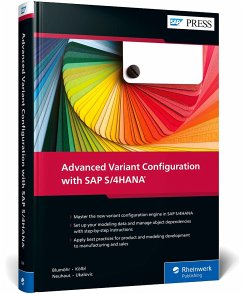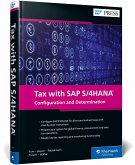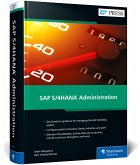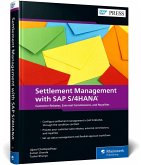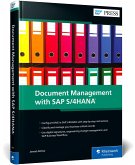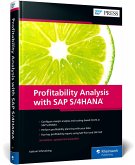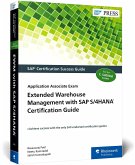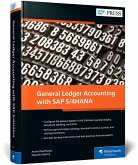- Gebundenes Buch
- Merkliste
- Auf die Merkliste
- Bewerten Bewerten
- Teilen
- Produkt teilen
- Produkterinnerung
- Produkterinnerung
Use SAP S/4HANA for advanced variant configuration to meet the individual requirements of your customers! Perform product modeling, from creating a configurable material and managing master data to setting up object dependencies, variant pricing, and material variants. Discover the most important integration points, including microservices on SAP Business Technology Platform (SAP BTP), SAP Commerce Cloud, SAP CPQ, and more. Incorporate industry best practices to get the most out of your AVC system!
Highlights include:
1) Configurable materials 2) Master data 3) Configuration profiles 4)…mehr
Andere Kunden interessierten sich auch für
![Tax with SAP S/4HANA Tax with SAP S/4HANA]() Michael FuhrTax with SAP S/4HANA72,99 €
Michael FuhrTax with SAP S/4HANA72,99 €![SAP S/4HANA Administration SAP S/4HANA Administration]() Mark MergaertsSAP S/4HANA Administration71,99 €
Mark MergaertsSAP S/4HANA Administration71,99 €![Settlement Management with SAP S/4HANA Settlement Management with SAP S/4HANA]() Ujjwal ChattopadhyaySettlement Management with SAP S/4HANA99,99 €
Ujjwal ChattopadhyaySettlement Management with SAP S/4HANA99,99 €![Document Management with SAP S/4HANA Document Management with SAP S/4HANA]() Jawad AkhtarDocument Management with SAP S/4HANA72,99 €
Jawad AkhtarDocument Management with SAP S/4HANA72,99 €![Profitability Analysis with SAP S/4HANA Profitability Analysis with SAP S/4HANA]() Kathrin SchmalzingProfitability Analysis with SAP S/4HANA72,99 €
Kathrin SchmalzingProfitability Analysis with SAP S/4HANA72,99 €![Extended Warehouse Management with SAP S/4HANA Certification Guide Extended Warehouse Management with SAP S/4HANA Certification Guide]() Basawaraj PatilExtended Warehouse Management with SAP S/4HANA Certification Guide64,99 €
Basawaraj PatilExtended Warehouse Management with SAP S/4HANA Certification Guide64,99 €![General Ledger Accounting with SAP S/4HANA General Ledger Accounting with SAP S/4HANA]() Anand SeetharajuGeneral Ledger Accounting with SAP S/4HANA72,99 €
Anand SeetharajuGeneral Ledger Accounting with SAP S/4HANA72,99 €-
-
-
Use SAP S/4HANA for advanced variant configuration to meet the individual requirements of your customers! Perform product modeling, from creating a configurable material and managing master data to setting up object dependencies, variant pricing, and material variants. Discover the most important integration points, including microservices on SAP Business Technology Platform (SAP BTP), SAP Commerce Cloud, SAP CPQ, and more. Incorporate industry best practices to get the most out of your AVC system!
Highlights include:
1) Configurable materials
2) Master data
3) Configuration profiles
4) Object dependencies
5) Variant pricing
6) Material variants
7) Integration
8) Best practices
9) Case studies
Highlights include:
1) Configurable materials
2) Master data
3) Configuration profiles
4) Object dependencies
5) Variant pricing
6) Material variants
7) Integration
8) Best practices
9) Case studies
Produktdetails
- Produktdetails
- SAP PRESS Englisch
- Verlag: Rheinwerk Verlag / SAP PRESS
- Artikelnr. des Verlages: 459/22358
- Seitenzahl: 567
- Erscheinungstermin: 6. März 2024
- Englisch
- Abmessung: 259mm x 187mm x 37mm
- Gewicht: 1326g
- ISBN-13: 9781493223589
- ISBN-10: 1493223585
- Artikelnr.: 68547703
- Herstellerkennzeichnung
- Rheinwerk Verlag GmbH
- Rheinwerkallee 4
- 53227 Bonn
- Info@rheinwerk-verlag.de
- +49228421500
- SAP PRESS Englisch
- Verlag: Rheinwerk Verlag / SAP PRESS
- Artikelnr. des Verlages: 459/22358
- Seitenzahl: 567
- Erscheinungstermin: 6. März 2024
- Englisch
- Abmessung: 259mm x 187mm x 37mm
- Gewicht: 1326g
- ISBN-13: 9781493223589
- ISBN-10: 1493223585
- Artikelnr.: 68547703
- Herstellerkennzeichnung
- Rheinwerk Verlag GmbH
- Rheinwerkallee 4
- 53227 Bonn
- Info@rheinwerk-verlag.de
- +49228421500
Dr. Uwe Blumöhr is Senior Education Consultant at SAP Germany. Since 1996, he has worked in the training and consulting area and he has many years of experience in the area of training, further education and qualification, in particular in variant configuration segment. Parts of the SAP training will form the basis for some sections of this book. Marin Ukalovic first experienced variant configuration in a training conducted by Dr. Uwe Blumöhr.
... Foreword ... 17
... Preface ... 21
Part I ... Basic Principles of Variant Configuration ... 25
1 ... Product Configuration with SAP ... 27
1.1 ... Generation Change: From SAP ERP to SAP S/4HANA ... 28
1.2 ... Generation Change: From LO-VC to AVC ... 32
1.3 ... Which SAP Configurators Are Available? ... 39
1.4 ... Product Configuration with AVC in an End-to-End Process ... 41
1.5 ... Managing Product Diversity ... 47
1.6 ... Manufacturing Scenarios for Configurable Products ... 50
1.7 ... Summary ... 52
2 ... The Path from LO-VC to AVC in SAP S/4HANA ... 53
2.1 ... AVC and LO-VC: An Either-Or? ... 53
2.2 ... Ways of Transformation ... 57
2.3 ... Basic Principles of the Transformation ... 58
2.4 ... Transition Workspaces ... 60
2.5 ... Transition Workbench ... 62
2.6 ... Comparing the Results ... 67
2.7 ... Transferring the Material Variants ... 70
2.8 ... An Exemplary Approach to Switching from VC to AVC (Greenfield versus Brownfield) ... 72
2.9 ... Summary ... 76
Part II ... Basics of Modeling ... 77
3 ... Creating Your First Configurable Material ... 79
3.1 ... Basic Principles ... 80
3.2 ... A First Example ... 82
3.3 ... The Configurable Material Master ... 84
3.4 ... Variant Classes, Characteristics, and Configuration Profiles ... 86
3.5 ... The Valuation Interface of the Extended Variant Configuration ... 90
3.6 ... Object Dependencies for Planning and Production ... 94
3.7 ... Configuration and Prices ... 97
3.8 ... Summary ... 100
4 ... Master Data in the Modeling Context ... 101
4.1 ... Variant Configuration Modeling Environment ... 101
4.2 ... AVC Simulation Environment ... 110
4.3 ... Tools from the Classification System ... 119
4.4 ... Material Master, Bill of Materials, and Routing of the Configurable Material ... 145
4.5 ... Configuration Profile and Configuration Scenarios ... 162
4.6 ... Characteristic Groups as User Interface Design ... 197
4.7 ... Summary ... 202
5 ... Object Dependencies ... 203
5.1 ... Basic Principles ... 203
5.2 ... Variant Tables ... 228
5.3 ... Object Dependencies for Interactive Configuration (High-Level Configuration) ... 240
5.4 ... Object Dependencies for a Bill of Materials and Routing (Low-Level Configuration) ... 271
5.5 ... Summary ... 281
6 ... Pricing ... 283
6.1 ... Pricing in Sales ... 283
6.2 ... Pricing on the Basis of Sales Order Costing ... 295
6.3 ... Pricing in Purchasing ... 296
6.4 ... Microservice for Pricing on SAP Business Technology Platform ... 306
6.5 ... Summary ... 311
7 ... Material Variants ... 313
7.1 ... Material Master ... 314
7.2 ... Bill of Materials ... 319
7.3 ... Routing ... 323
7.4 ... Pricing ... 328
7.5 ... Variant Matching ... 328
7.6 ... Summary ... 336
Part III ... Integration ... 337
8 ... Integrating Variant Configuration in Platforms via Knowledge Bases and Runtime Versions ... 339
8.1 ... Architecture ... 339
8.2 ... Master Data for Configuration Integration: Knowledge Bases and Runtime Versions ... 342
8.3 ... Tips for Generating Knowledge Base Runtime Versions ... 346
8.4 ... Instructions for (Re)generating Runtime Versions ... 365
8.5 ... Using the Configuration Microservice in SAP BTP ... 373
8.6 ... Variant Configuration in SAP Commerce Cloud ... 375
8.7 ... Integrated Variant Configuration in SAP CPQ ... 379
8.8 ... Summary ... 386
9 ... New Integration Aspects for Variant Configuration ... 387
9.1 ... Master Data Distribution with Product Data Replication ... 387
9.2 ... SAP Variant Configuration with SAP Teamcenter ... 424
9.3 ... Requirements Management and Documentation in Modeling: SAP Enterprise Product Development ... 432
9.4 ... Machine Learning and Artificial Intelligence for Configurable Products ... 437
9.5 ... Integrating AVC with SAP Workflow Management ... 447
9.6 ... Two-Tier Scenario: Cross-System Procurement of Configured Products ... 453
9.7 ... Summary ... 456
10 ... Solutions from SAP Partners ... 457
10.1 ... 3D Configuration ... 457
10.2 ... Artificial Intelligence-Optimized Processing of Customer Requests ... 470
10.3 ... Variant Table Contents on SAP Business Technology Platform ... 482
10.4 ... Variant Configuration with Machine Learning ... 492
10.5 ... Hybrid System Configuration, End-to-End Automation, and API-Based Integration with SAP Solutions ... 503
10.6 ... Summary ... 513
Part IV ... Industry Best Practices ... 517
11 ... Case Study: Transformation from LO-VC to AVC ... 519
11.1 ... AVC Preliminary Study ... 519
11.2 ... Best Practice Transformation: A Real-Life Example ... 526
11.3 ... Summary ... 532
12 ... SAP Variant Configuration Communities ... 533
12.1 ... Configuration Working Group ... 533
12.2 ... The DSAG Variant Configuration Working Group ... 543
12.3 ... SAP AVC Customer Co-Innovation Council ... 546
12.4 ... Summary ... 547
... The Authors ... 549
... Authors ... 549
... Contributors ... 550
... Foreword Authors ... 557
... Index ... 559
... Preface ... 21
Part I ... Basic Principles of Variant Configuration ... 25
1 ... Product Configuration with SAP ... 27
1.1 ... Generation Change: From SAP ERP to SAP S/4HANA ... 28
1.2 ... Generation Change: From LO-VC to AVC ... 32
1.3 ... Which SAP Configurators Are Available? ... 39
1.4 ... Product Configuration with AVC in an End-to-End Process ... 41
1.5 ... Managing Product Diversity ... 47
1.6 ... Manufacturing Scenarios for Configurable Products ... 50
1.7 ... Summary ... 52
2 ... The Path from LO-VC to AVC in SAP S/4HANA ... 53
2.1 ... AVC and LO-VC: An Either-Or? ... 53
2.2 ... Ways of Transformation ... 57
2.3 ... Basic Principles of the Transformation ... 58
2.4 ... Transition Workspaces ... 60
2.5 ... Transition Workbench ... 62
2.6 ... Comparing the Results ... 67
2.7 ... Transferring the Material Variants ... 70
2.8 ... An Exemplary Approach to Switching from VC to AVC (Greenfield versus Brownfield) ... 72
2.9 ... Summary ... 76
Part II ... Basics of Modeling ... 77
3 ... Creating Your First Configurable Material ... 79
3.1 ... Basic Principles ... 80
3.2 ... A First Example ... 82
3.3 ... The Configurable Material Master ... 84
3.4 ... Variant Classes, Characteristics, and Configuration Profiles ... 86
3.5 ... The Valuation Interface of the Extended Variant Configuration ... 90
3.6 ... Object Dependencies for Planning and Production ... 94
3.7 ... Configuration and Prices ... 97
3.8 ... Summary ... 100
4 ... Master Data in the Modeling Context ... 101
4.1 ... Variant Configuration Modeling Environment ... 101
4.2 ... AVC Simulation Environment ... 110
4.3 ... Tools from the Classification System ... 119
4.4 ... Material Master, Bill of Materials, and Routing of the Configurable Material ... 145
4.5 ... Configuration Profile and Configuration Scenarios ... 162
4.6 ... Characteristic Groups as User Interface Design ... 197
4.7 ... Summary ... 202
5 ... Object Dependencies ... 203
5.1 ... Basic Principles ... 203
5.2 ... Variant Tables ... 228
5.3 ... Object Dependencies for Interactive Configuration (High-Level Configuration) ... 240
5.4 ... Object Dependencies for a Bill of Materials and Routing (Low-Level Configuration) ... 271
5.5 ... Summary ... 281
6 ... Pricing ... 283
6.1 ... Pricing in Sales ... 283
6.2 ... Pricing on the Basis of Sales Order Costing ... 295
6.3 ... Pricing in Purchasing ... 296
6.4 ... Microservice for Pricing on SAP Business Technology Platform ... 306
6.5 ... Summary ... 311
7 ... Material Variants ... 313
7.1 ... Material Master ... 314
7.2 ... Bill of Materials ... 319
7.3 ... Routing ... 323
7.4 ... Pricing ... 328
7.5 ... Variant Matching ... 328
7.6 ... Summary ... 336
Part III ... Integration ... 337
8 ... Integrating Variant Configuration in Platforms via Knowledge Bases and Runtime Versions ... 339
8.1 ... Architecture ... 339
8.2 ... Master Data for Configuration Integration: Knowledge Bases and Runtime Versions ... 342
8.3 ... Tips for Generating Knowledge Base Runtime Versions ... 346
8.4 ... Instructions for (Re)generating Runtime Versions ... 365
8.5 ... Using the Configuration Microservice in SAP BTP ... 373
8.6 ... Variant Configuration in SAP Commerce Cloud ... 375
8.7 ... Integrated Variant Configuration in SAP CPQ ... 379
8.8 ... Summary ... 386
9 ... New Integration Aspects for Variant Configuration ... 387
9.1 ... Master Data Distribution with Product Data Replication ... 387
9.2 ... SAP Variant Configuration with SAP Teamcenter ... 424
9.3 ... Requirements Management and Documentation in Modeling: SAP Enterprise Product Development ... 432
9.4 ... Machine Learning and Artificial Intelligence for Configurable Products ... 437
9.5 ... Integrating AVC with SAP Workflow Management ... 447
9.6 ... Two-Tier Scenario: Cross-System Procurement of Configured Products ... 453
9.7 ... Summary ... 456
10 ... Solutions from SAP Partners ... 457
10.1 ... 3D Configuration ... 457
10.2 ... Artificial Intelligence-Optimized Processing of Customer Requests ... 470
10.3 ... Variant Table Contents on SAP Business Technology Platform ... 482
10.4 ... Variant Configuration with Machine Learning ... 492
10.5 ... Hybrid System Configuration, End-to-End Automation, and API-Based Integration with SAP Solutions ... 503
10.6 ... Summary ... 513
Part IV ... Industry Best Practices ... 517
11 ... Case Study: Transformation from LO-VC to AVC ... 519
11.1 ... AVC Preliminary Study ... 519
11.2 ... Best Practice Transformation: A Real-Life Example ... 526
11.3 ... Summary ... 532
12 ... SAP Variant Configuration Communities ... 533
12.1 ... Configuration Working Group ... 533
12.2 ... The DSAG Variant Configuration Working Group ... 543
12.3 ... SAP AVC Customer Co-Innovation Council ... 546
12.4 ... Summary ... 547
... The Authors ... 549
... Authors ... 549
... Contributors ... 550
... Foreword Authors ... 557
... Index ... 559
... Foreword ... 17
... Preface ... 21
Part I ... Basic Principles of Variant Configuration ... 25
1 ... Product Configuration with SAP ... 27
1.1 ... Generation Change: From SAP ERP to SAP S/4HANA ... 28
1.2 ... Generation Change: From LO-VC to AVC ... 32
1.3 ... Which SAP Configurators Are Available? ... 39
1.4 ... Product Configuration with AVC in an End-to-End Process ... 41
1.5 ... Managing Product Diversity ... 47
1.6 ... Manufacturing Scenarios for Configurable Products ... 50
1.7 ... Summary ... 52
2 ... The Path from LO-VC to AVC in SAP S/4HANA ... 53
2.1 ... AVC and LO-VC: An Either-Or? ... 53
2.2 ... Ways of Transformation ... 57
2.3 ... Basic Principles of the Transformation ... 58
2.4 ... Transition Workspaces ... 60
2.5 ... Transition Workbench ... 62
2.6 ... Comparing the Results ... 67
2.7 ... Transferring the Material Variants ... 70
2.8 ... An Exemplary Approach to Switching from VC to AVC (Greenfield versus Brownfield) ... 72
2.9 ... Summary ... 76
Part II ... Basics of Modeling ... 77
3 ... Creating Your First Configurable Material ... 79
3.1 ... Basic Principles ... 80
3.2 ... A First Example ... 82
3.3 ... The Configurable Material Master ... 84
3.4 ... Variant Classes, Characteristics, and Configuration Profiles ... 86
3.5 ... The Valuation Interface of the Extended Variant Configuration ... 90
3.6 ... Object Dependencies for Planning and Production ... 94
3.7 ... Configuration and Prices ... 97
3.8 ... Summary ... 100
4 ... Master Data in the Modeling Context ... 101
4.1 ... Variant Configuration Modeling Environment ... 101
4.2 ... AVC Simulation Environment ... 110
4.3 ... Tools from the Classification System ... 119
4.4 ... Material Master, Bill of Materials, and Routing of the Configurable Material ... 145
4.5 ... Configuration Profile and Configuration Scenarios ... 162
4.6 ... Characteristic Groups as User Interface Design ... 197
4.7 ... Summary ... 202
5 ... Object Dependencies ... 203
5.1 ... Basic Principles ... 203
5.2 ... Variant Tables ... 228
5.3 ... Object Dependencies for Interactive Configuration (High-Level Configuration) ... 240
5.4 ... Object Dependencies for a Bill of Materials and Routing (Low-Level Configuration) ... 271
5.5 ... Summary ... 281
6 ... Pricing ... 283
6.1 ... Pricing in Sales ... 283
6.2 ... Pricing on the Basis of Sales Order Costing ... 295
6.3 ... Pricing in Purchasing ... 296
6.4 ... Microservice for Pricing on SAP Business Technology Platform ... 306
6.5 ... Summary ... 311
7 ... Material Variants ... 313
7.1 ... Material Master ... 314
7.2 ... Bill of Materials ... 319
7.3 ... Routing ... 323
7.4 ... Pricing ... 328
7.5 ... Variant Matching ... 328
7.6 ... Summary ... 336
Part III ... Integration ... 337
8 ... Integrating Variant Configuration in Platforms via Knowledge Bases and Runtime Versions ... 339
8.1 ... Architecture ... 339
8.2 ... Master Data for Configuration Integration: Knowledge Bases and Runtime Versions ... 342
8.3 ... Tips for Generating Knowledge Base Runtime Versions ... 346
8.4 ... Instructions for (Re)generating Runtime Versions ... 365
8.5 ... Using the Configuration Microservice in SAP BTP ... 373
8.6 ... Variant Configuration in SAP Commerce Cloud ... 375
8.7 ... Integrated Variant Configuration in SAP CPQ ... 379
8.8 ... Summary ... 386
9 ... New Integration Aspects for Variant Configuration ... 387
9.1 ... Master Data Distribution with Product Data Replication ... 387
9.2 ... SAP Variant Configuration with SAP Teamcenter ... 424
9.3 ... Requirements Management and Documentation in Modeling: SAP Enterprise Product Development ... 432
9.4 ... Machine Learning and Artificial Intelligence for Configurable Products ... 437
9.5 ... Integrating AVC with SAP Workflow Management ... 447
9.6 ... Two-Tier Scenario: Cross-System Procurement of Configured Products ... 453
9.7 ... Summary ... 456
10 ... Solutions from SAP Partners ... 457
10.1 ... 3D Configuration ... 457
10.2 ... Artificial Intelligence-Optimized Processing of Customer Requests ... 470
10.3 ... Variant Table Contents on SAP Business Technology Platform ... 482
10.4 ... Variant Configuration with Machine Learning ... 492
10.5 ... Hybrid System Configuration, End-to-End Automation, and API-Based Integration with SAP Solutions ... 503
10.6 ... Summary ... 513
Part IV ... Industry Best Practices ... 517
11 ... Case Study: Transformation from LO-VC to AVC ... 519
11.1 ... AVC Preliminary Study ... 519
11.2 ... Best Practice Transformation: A Real-Life Example ... 526
11.3 ... Summary ... 532
12 ... SAP Variant Configuration Communities ... 533
12.1 ... Configuration Working Group ... 533
12.2 ... The DSAG Variant Configuration Working Group ... 543
12.3 ... SAP AVC Customer Co-Innovation Council ... 546
12.4 ... Summary ... 547
... The Authors ... 549
... Authors ... 549
... Contributors ... 550
... Foreword Authors ... 557
... Index ... 559
... Preface ... 21
Part I ... Basic Principles of Variant Configuration ... 25
1 ... Product Configuration with SAP ... 27
1.1 ... Generation Change: From SAP ERP to SAP S/4HANA ... 28
1.2 ... Generation Change: From LO-VC to AVC ... 32
1.3 ... Which SAP Configurators Are Available? ... 39
1.4 ... Product Configuration with AVC in an End-to-End Process ... 41
1.5 ... Managing Product Diversity ... 47
1.6 ... Manufacturing Scenarios for Configurable Products ... 50
1.7 ... Summary ... 52
2 ... The Path from LO-VC to AVC in SAP S/4HANA ... 53
2.1 ... AVC and LO-VC: An Either-Or? ... 53
2.2 ... Ways of Transformation ... 57
2.3 ... Basic Principles of the Transformation ... 58
2.4 ... Transition Workspaces ... 60
2.5 ... Transition Workbench ... 62
2.6 ... Comparing the Results ... 67
2.7 ... Transferring the Material Variants ... 70
2.8 ... An Exemplary Approach to Switching from VC to AVC (Greenfield versus Brownfield) ... 72
2.9 ... Summary ... 76
Part II ... Basics of Modeling ... 77
3 ... Creating Your First Configurable Material ... 79
3.1 ... Basic Principles ... 80
3.2 ... A First Example ... 82
3.3 ... The Configurable Material Master ... 84
3.4 ... Variant Classes, Characteristics, and Configuration Profiles ... 86
3.5 ... The Valuation Interface of the Extended Variant Configuration ... 90
3.6 ... Object Dependencies for Planning and Production ... 94
3.7 ... Configuration and Prices ... 97
3.8 ... Summary ... 100
4 ... Master Data in the Modeling Context ... 101
4.1 ... Variant Configuration Modeling Environment ... 101
4.2 ... AVC Simulation Environment ... 110
4.3 ... Tools from the Classification System ... 119
4.4 ... Material Master, Bill of Materials, and Routing of the Configurable Material ... 145
4.5 ... Configuration Profile and Configuration Scenarios ... 162
4.6 ... Characteristic Groups as User Interface Design ... 197
4.7 ... Summary ... 202
5 ... Object Dependencies ... 203
5.1 ... Basic Principles ... 203
5.2 ... Variant Tables ... 228
5.3 ... Object Dependencies for Interactive Configuration (High-Level Configuration) ... 240
5.4 ... Object Dependencies for a Bill of Materials and Routing (Low-Level Configuration) ... 271
5.5 ... Summary ... 281
6 ... Pricing ... 283
6.1 ... Pricing in Sales ... 283
6.2 ... Pricing on the Basis of Sales Order Costing ... 295
6.3 ... Pricing in Purchasing ... 296
6.4 ... Microservice for Pricing on SAP Business Technology Platform ... 306
6.5 ... Summary ... 311
7 ... Material Variants ... 313
7.1 ... Material Master ... 314
7.2 ... Bill of Materials ... 319
7.3 ... Routing ... 323
7.4 ... Pricing ... 328
7.5 ... Variant Matching ... 328
7.6 ... Summary ... 336
Part III ... Integration ... 337
8 ... Integrating Variant Configuration in Platforms via Knowledge Bases and Runtime Versions ... 339
8.1 ... Architecture ... 339
8.2 ... Master Data for Configuration Integration: Knowledge Bases and Runtime Versions ... 342
8.3 ... Tips for Generating Knowledge Base Runtime Versions ... 346
8.4 ... Instructions for (Re)generating Runtime Versions ... 365
8.5 ... Using the Configuration Microservice in SAP BTP ... 373
8.6 ... Variant Configuration in SAP Commerce Cloud ... 375
8.7 ... Integrated Variant Configuration in SAP CPQ ... 379
8.8 ... Summary ... 386
9 ... New Integration Aspects for Variant Configuration ... 387
9.1 ... Master Data Distribution with Product Data Replication ... 387
9.2 ... SAP Variant Configuration with SAP Teamcenter ... 424
9.3 ... Requirements Management and Documentation in Modeling: SAP Enterprise Product Development ... 432
9.4 ... Machine Learning and Artificial Intelligence for Configurable Products ... 437
9.5 ... Integrating AVC with SAP Workflow Management ... 447
9.6 ... Two-Tier Scenario: Cross-System Procurement of Configured Products ... 453
9.7 ... Summary ... 456
10 ... Solutions from SAP Partners ... 457
10.1 ... 3D Configuration ... 457
10.2 ... Artificial Intelligence-Optimized Processing of Customer Requests ... 470
10.3 ... Variant Table Contents on SAP Business Technology Platform ... 482
10.4 ... Variant Configuration with Machine Learning ... 492
10.5 ... Hybrid System Configuration, End-to-End Automation, and API-Based Integration with SAP Solutions ... 503
10.6 ... Summary ... 513
Part IV ... Industry Best Practices ... 517
11 ... Case Study: Transformation from LO-VC to AVC ... 519
11.1 ... AVC Preliminary Study ... 519
11.2 ... Best Practice Transformation: A Real-Life Example ... 526
11.3 ... Summary ... 532
12 ... SAP Variant Configuration Communities ... 533
12.1 ... Configuration Working Group ... 533
12.2 ... The DSAG Variant Configuration Working Group ... 543
12.3 ... SAP AVC Customer Co-Innovation Council ... 546
12.4 ... Summary ... 547
... The Authors ... 549
... Authors ... 549
... Contributors ... 550
... Foreword Authors ... 557
... Index ... 559

